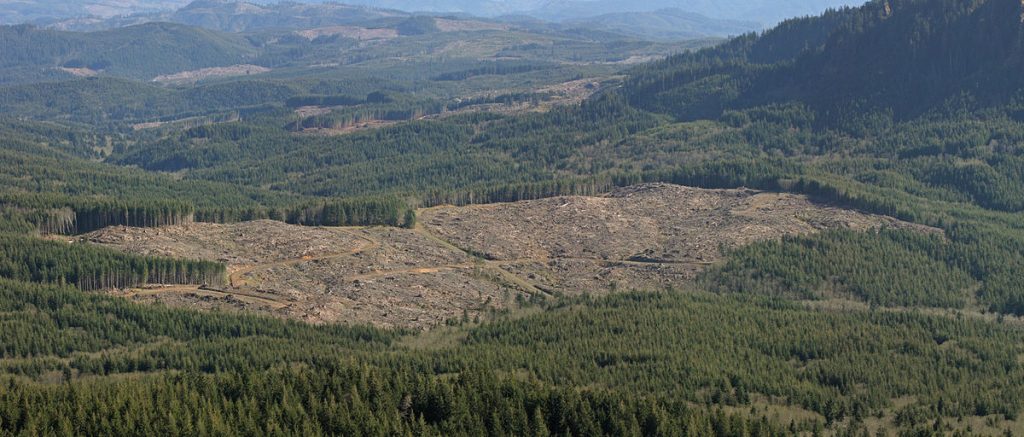Forest Conservation Report: U.S. Gov. Severely Underestimating Impact of Logging on Climate

(EnviroNews USA Headline News Desk) — The North Carolina forest conservation group Dogwood Alliance published a report called, “The Great American Stand: U.S. Forests and the Climate Emergency,” in late March 2017. In the analysis, the authors evaluate the effects of U.S. logging on carbon emissions and climate change and reveal the government is significantly underestimating the negative impact of logging.
Key findings outlined in the paper show logging activities in the U.S. have diminished the country’s net forest carbon sink by at least 35 percent. This data was gleaned from a 2016 study in the journal, Carbon Balance and Management. Additionally, the Dogwood Alliance draws on satellite data from a 2013 investigation published in Science, which shows forest disturbance from logging in the southern United States between 2000 and 2012 was four times that of South American rainforests.
Co-author Danna Smith and her colleagues calculated annual logging carbon emissions between 2006 and 2010 were greater than the combined yearly emissions from residential and commercial buildings. The study calls forests “the only proven system” we have for meeting the goals set under the Paris Agreement (Paris accord), which include keeping the rise in global temperature to below 2°C. The paper states:
To avoid serious climate disruption, it is essential that we simultaneously reduce emissions of carbon dioxide from burning fossil fuels and bioenergy along with other heat trapping gases and accelerate the removal of carbon dioxide from the atmosphere by protecting and expanding forests. It is not one or the other. It is both!
A related Dogwood Alliance press release explains that according to recent Environmental Protection Agency (EPA) greenhouse gas emission estimates, U.S. forests remove an amount of carbon equal to about 11-13 percent of our nation’s emissions. This is about half that of the global average; most country’s forests sequester about 25 percent of their emissions. The press release describes the current rate of U.S. forest carbon uptake as, “a fraction of what is needed to avoid climate catastrophe.”
The paper also points out U.S. logging and carbon stats don’t adequately factor in the loss of old forests, which typically store large amounts of carbon, or the significant soil emissions associated with logging. The press release also states the EPA’s reporting on forest carbon sink degradation and logging emissions is not transparent and is further designed to shield the U.S. timber industry. According to the U.S. Department of Agriculture (USDA), the U.S was the world’s fourth-largest exporter of forest products in 2015 and exported $9.7 billion in forest-related goods in the 2014 fiscal year.
Old-Growth Forest in California’s Sequoia National Park
Ryan Rhodes, Director of Public Relations and Government Affairs for the Forest Resources Association, which represents the timber industry, told Inside Climate News that the logging sector protects forests. He says the U.S. has a greater number of timberland acres now than in 1950 and, “Markets keep working forests working.”
The Dogwood Alliance paper also questions the classification of burning wood as “carbon neutral,” particularly as it pertains to the recent U.S. budget deal. The environmental cost and benefits of burning biomass, which usually consist of plant material or wood chips, has been highly debated.
As journalist Warren Cornwall wrote in Science, proponents of burning wood claim the planting of new trees effectively cancels out the carbon released when trees are cut and burned. But, Cornwall also explained wood-burning furnaces can sometimes actually emit more CO2 than coal or natural gas, in part because wood requires extra energy to boil off its high water content.
“We can’t log our way out of climate change. Burning wood products actually contributes more toward the increase of emissions into the atmosphere,” Kirin Kennedy, Associate Legislative Director for Lands at Wildlife at the Sierra Club, told Inside Climate News.
“Bioenergy carbon capture and storage” is the process of capturing some portion of wood combustion carbon emissions and storing it underground. The Dogwood Alliance points out in “The Great American Stand: U.S. Forests and the Climate Emergency,” that this technology is in the pilot stages and is very inefficient.
Smith explains that inconsistency in reporting forest-related emissions under the UN climate regime is another troublesome issue. For example, when the U.S converts forests to timber plantations, it calls it “reforestation.” In contrast, Indonesia calls the transformation of forests into palm oil plantations “deforestation.”
“We’re not getting it yet that forests are a critical part of the solution,” Smith told Inside Climate News. “We’re not looking in our own backyard, and yet, we’re telling the rest of the world what to do.”
RELATED NEWS FROM ENVIRONEWS
What Are We Doing?! STUDY: On Current Course, Zero Wilderness Areas Will Remain in 100 Yrs.
(EnviroNews World News) – In the last 25 years, the world has lost 10% of its wilderness areas to human encroachment and development according to a study published in Current Biology. The authors say these losses are not only devastating to the animals that live in the wilderness…
FILM AND ARTICLE CREDITS
- Julia Travers - Journalist, Author



